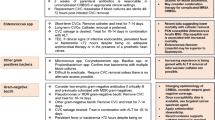Abstract
The ideal number of blood samples to be obtained from peripheral veins (PVs) when differential time to positivity (DTTP) is being performed is an unresolved issue and most institutions obtain a single set. Our objective was to assess the number of proven central line-associated bloodstream infection (CLABSI) episodes that would have been recovered if blood had been cultured from one or two PVs. We performed a retrospective study in patients with proven CLABSI in which catheter lumens and two or more PV blood cultures were taken simultaneously. We calculated the number of episodes that would have been recovered if the culture of one or more PV blood cultures had been artificially eliminated. During a period of 4 years, we collected 60 episodes of proven CLABSI. Overall, if one PV culture had been eliminated in patients with two or three PV blood cultures, we would have documented 91.8% (p = 0.362) and 96.9% (p > 0.999) of episodes, respectively. If we had eliminated two PV blood cultures in patients with three PV blood cultures, 90.8% (p > 0.999) of episodes would have been documented. When performing the DTTP technique to confirm CLABSI, a single paired PV blood culture was not associated with a significant number of missed CLABSI episodes.
Similar content being viewed by others
References
Mermel LA, Allon M, Bouza E, Craven DE, Flynn P, O’Grady NP et al (2009) Clinical practice guidelines for the diagnosis and management of intravascular catheter-related infection: 2009 Update by the Infectious Diseases Society of America. Clin Infect Dis 49(1):1–45
Bouza E, Alvarado N, Alcalá L, Pérez MJ, Rincón C, Muñoz P (2007) A randomized and prospective study of 3 procedures for the diagnosis of catheter-related bloodstream infection without catheter withdrawal. Clin Infect Dis 44(6):820–826
Catton JA, Dobbins BM, Kite P, Wood JM, Eastwood K, Sugden S et al (2005) In situ diagnosis of intravascular catheter-related bloodstream infection: a comparison of quantitative culture, differential time to positivity, and endoluminal brushing. Crit Care Med 33(4):787–791
Blot F, Nitenberg G, Chachaty E, Raynard B, Germann N, Antoun S et al (1999) Diagnosis of catheter-related bacteraemia: a prospective comparison of the time to positivity of hub-blood versus peripheral-blood cultures. Lancet 354(9184):1071–1077
Quilici N, Audibert G, Conroy MC, Bollaert PE, Guillemin F, Welfringer P et al (1997) Differential quantitative blood cultures in the diagnosis of catheter-related sepsis in intensive care units. Clin Infect Dis 25(5):1066–1070
O’Hara CM, Weinstein MP, Miller JM (2003) Manual and automated systems for detection and identification of microorganisms. In: Murray PR, Baron EJ, Jorgensen JH, Pfaller MA, Yolken RH (eds) Manual of clinical microbiology, 8th edn. American Society for Microbiology Press, Washington, DC, pp 185–207
Bouza E, Burillo A, Muñoz P (2002) Catheter-related infections: diagnosis and intravascular treatment. Clin Microbiol Infect 8(5):265–274
Raad I, Hanna HA, Alakech B, Chatzinikolaou I, Johnson MM, Tarrand J (2004) Differential time to positivity: a useful method for diagnosing catheter-related bloodstream infections. Ann Intern Med 140(1):18–25
Chatzinikolaou I, Hanna H, Hachem R, Alakech B, Tarrand J, Raad I (2004) Differential quantitative blood cultures for the diagnosis of catheter-related bloodstream infections associated with short- and long-term catheters: a prospective study. Diagn Microbiol Infect Dis 50(3):167–172
Al Wohoush I, Cairo J, Rangaraj G, Granwehr B, Hachem R, Raad I (2010) Comparing quantitative culture of a blood sample obtained through the catheter with differential time to positivity in establishing a diagnosis of catheter-related bloodstream infection. Infect Control Hosp Epidemiol 31(10):1089–1091
Blot F, Schmidt E, Nitenberg G, Tancrède C, Leclercq B, Laplanche A et al (1998) Earlier positivity of central-venous- versus peripheral-blood cultures is highly predictive of catheter-related sepsis. J Clin Microbiol 36(1):105–109
Chen WT, Liu TM, Wu SH, Tan TD, Tseng HC, Shih CC (2009) Improving diagnosis of central venous catheter-related bloodstream infection by using differential time to positivity as a hospital-wide approach at a cancer hospital. J Infect 59(5):317–323
Seifert H, Cornely O, Seggewiss K, Decker M, Stefanik D, Wisplinghoff H et al (2003) Bloodstream infection in neutropenic cancer patients related to short-term nontunnelled catheters determined by quantitative blood cultures, differential time to positivity, and molecular epidemiological typing with pulsed-field gel electrophoresis. J Clin Microbiol 41(1):118–123
Guembe M, Rodríguez-Créixems M, Sánchez-Carrillo C, Pérez-Parra A, Martín-Rabadán P, Bouza E (2010) How many lumens should be cultured in the conservative diagnosis of catheter-related bloodstream infections? Clin Infect Dis 50(12):1575–1579
Bates DW, Goldman L, Lee TH (1991) Contaminant blood cultures and resource utilization. The true consequences of false-positive results. JAMA 265(3):365–369
DesJardin JA, Falagas ME, Ruthazer R, Griffith J, Wawrose D, Schenkein D et al (1999) Clinical utility of blood cultures drawn from indwelling central venous catheters in hospitalized patients with cancer. Ann Intern Med 131(9):641–647
Robinson JL (2002) Sensitivity of a blood culture drawn through a single lumen of a multilumen, long-term, indwelling, central venous catheter in pediatric oncology patients. J Pediatr Hematol Oncol 24(1):72–74
Acknowledgments
We thank Thomas O’Boyle for his help in the preparation of the manuscript and Cristina Fernández for the statistical analysis.
Potential conflicts of interest
The authors declare no conflicts of interest.
Author information
Authors and Affiliations
Corresponding authors
Rights and permissions
About this article
Cite this article
Guembe, M., Rodríguez-Créixems, M., Sánchez-Carrillo, C. et al. Differential time to positivity (DTTP) for the diagnosis of catheter-related bloodstream infection: do we need to obtain one or more peripheral vein blood cultures?. Eur J Clin Microbiol Infect Dis 31, 1367–1372 (2012). https://doi.org/10.1007/s10096-011-1451-3
Received:
Accepted:
Published:
Issue Date:
DOI: https://doi.org/10.1007/s10096-011-1451-3




